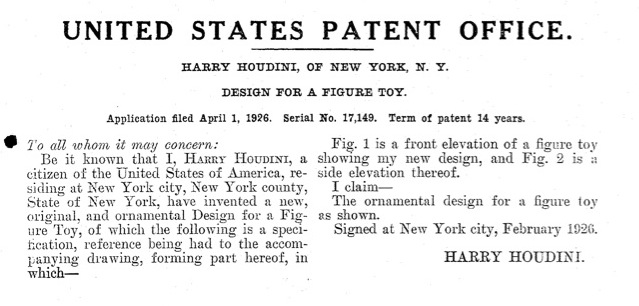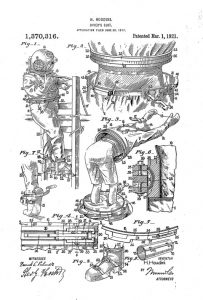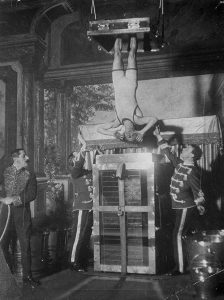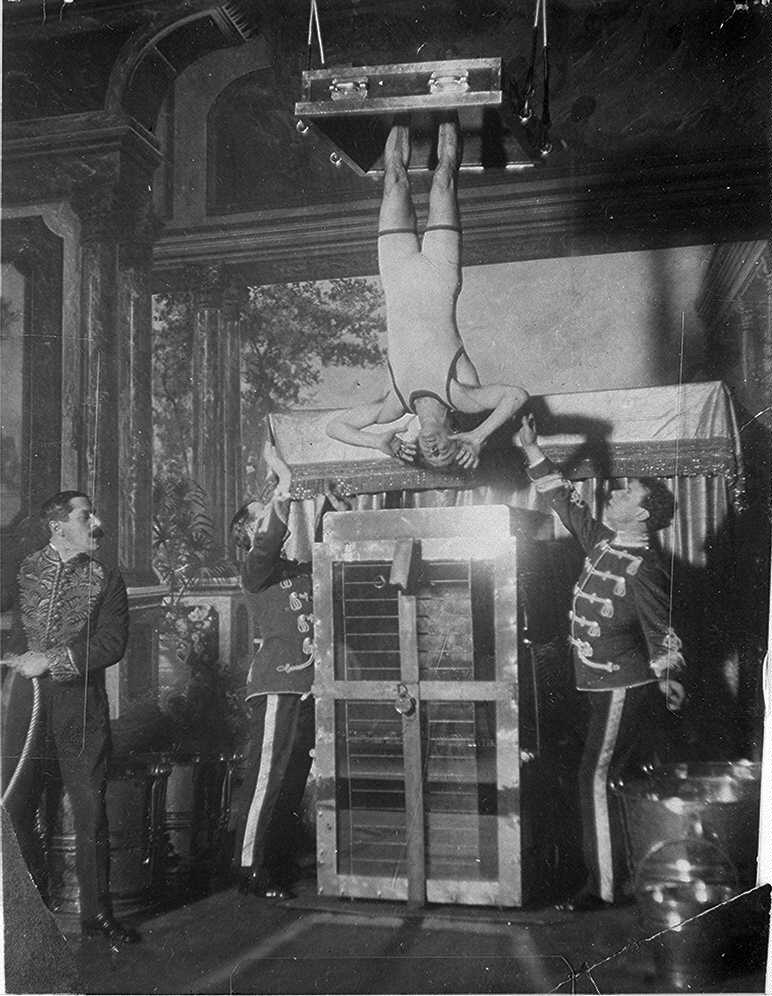Intellectual property (IP) law probably isn’t the first thing you think of when you think of Harry Houdini. One probably envisions dramatic performances involving straightjackets, water barrels, or sleight of hand illusions. However, Houdini’s greatest trick may have been leveraging IP to his personal advantage.
While many know of the magician for his impressive feats of escape, the Hungarian-born immigrant was also an avid inventor. Harry Houdini, born Erik Weitz, came of age during the Industrial Revolution. As a product of his time, Houdini had high esteem for feats of mechanical engineering. This, along with a few other incentives discussed later, led him to patent the machines he created for his magic performances.
He designed created new machines that would dazzle his audiences with exciting performances. Patenting his inventions served a few important functions for Houdini. But before describing those functions, let’s first explain how patents work and what they do.
PATENTS — WHAT ARE THEY?
Patent law (and copyright law) has its roots in the Constitution. Clause 8 (Art. 1, Sec. 8, Cl. 8) grants Congress the power “[t]o promote the progress of science.” By issuing individuals a patent, the government gives inventors a temporary monopoly over their invention for the 20-year patent term. This offers a financial incentive for others to invent new things that solve previously unresolved problems.
Patents enable the patent holder to exclude all others from the ability to make, use, sell, offer to sell, or even import any patented material without consent of the patent holder. Even inventors who did not know they are infringing a patent can still be held liable for patent infringement.
Those interested in obtaining a patent are required to submit a detailed explanation of the invention along with drawings to the U.S. Patent and Trademark Office (USPTO). The invention must be explained to such a degree that a similar inventor in the same field could recreate the device. In patent law, this is known as a “person of ordinary skill in the art.”
If the application meets certain statutory requirements, the USPTO issues the patent. These requirements include the invention being useful, novel, and “non-obvious” (i.e., not something that would easily be created by similar inventors in the same field or a “person of ordinary skill in the art”).The application is published by the USPTO.

By patenting his machines, Houdini had the exclusive right to exclude all others from making and using his machines. Patents allowed Houdini to stop copycat performers from using his machines in their acts for the duration of his patent.
HOUDINI THE INNOVATOR
Houdini filed several patents both in the U.S. and abroad for mechanisms that would help him escape various feats of danger. He applied for a German patent for a set of nested boxes, that were designed to be locked and placed inside of each other, with the outer box filled with water and locked. While he never performed with this device, it would allow Houdini to escape from two sets of locked and water filled boxes without getting wet. He also applied for another German patent that would allow him to be frozen inside of a giant block of ice, pretty cool!
The concepts behind his German trick are what lead him to design his most famous act: milk container escape act. In this act, he would climb inside a steel drum that was filled with water. The lid would be padlocked shut with several locks and chains, and of course, after several minutes Houdini would escape unscathed. Houdini also patented a set quick release handcuffs.
Not all of his patents were related to magic. He patented a quick-release diving suit. This suit would allow a trapped diver to quickly remove his suit and swim to the surface should his air supply be compromised. While Houdini never used this in his act, this potentially life-saving technology was sold to the U.S. Navy, with the hope that it could decrease the risk of accidental drownings. He even patented a small Harry Houdini toy that would escape from a straitjacket.

Patents still posed a problem for Houdini despite his success with obtaining them. Houdini was notoriously secretive and protective of his work. To receive a patent, patent applications must disclose how the machine is made and how it works. Patent applications are published by the USPTO and made publicly available. Patent holders have a limited monopoly, but once the patent term expires the technology belongs to the public so others can make, use, sell and import the technology without risk of infringement.
Herein lies Houdini’s problem with patents. Secrecy is paramount to any magician’s act. Because the explanations of his machines would be public, his patents risked exposing too much of his work. If other magicians or his fans understood how to make his devices, it would spoil his illusion and injure his livelihood. To get around this issue, like the good escape artist he was, Houdini found a back door solution to his patent problem: copyright.
A CREATIVE SOLUTION IN COPYRIGHT
Houdini turned to a different IP tool to help him secure a different right in his magic tricks: copyright.
Copyright is a different IP right with different protections. Unlike patents, a valid copyright does not require a detailed explanation of the copyrighted work. While patents protect useful and novel inventions, copyright protects expression such as writing and music. More specifically, copyright protects original works of authorship (meaning not copied from someone else but not necessarily a “new idea”) that are “fixed” (sufficiently permanent) in a tangible medium of expression (like a piece of paper, canvas, etc.) so long as it is minimally creative.
The “minimally creative” requirement is an easy one to meet. Courts do not judge what is creative based on the merits of the art or skill or the artist. As long as the work involved some level of creative choice and expression, the bar is met. While facts, blank forms, laws of nature are not copyrightable because they are ideas that are not unique expressions – the way ideas are expressed can be copyrightable.
Title 17 U.S.C § 102 spells out categories of protectable “works of authorship,” including (but not limited to) literary, musical, dramatic works, choreographic works, pictorial, graphic or sculptural works, motion pictures, audiovisual works, sound recordings, and architectural works. Copyright protection for works made after 1978 lasts as long as the life of the author plus an additional 70 years, but it varies depending on some facts about the work (See 17 U.S.C. § 302).
Anyone with a valid copyright can prevent others from reproducing their work, distributing copies of their work, publicly performing their work, or publicly displaying it. Anything that is too substantially similar, that copies too much expressive content from the original work without permission, would be in violation of the copyright (See U.S.C. § 106). It also prevents others from making “unauthorized derivative works” from their work. A derivative work is something that is based off of a copyrighted work. A good example is a film adaption of a book.
So rather than protecting his useful inventions, Houdini decided to protect the expressive elements of his illusions and performances.
COPYRIGHTING THE “CHINESE WATER TORTURE CELL”
In August of 1911, Houdini performed a one act play in London titled “Harry Houdini! Upside Down!” to an audience of one person. The trick involved Houdini being suspended mid-air, dangling over a tank filled with water. His legs were locked in a stock and shackles before being fully submerged into the tank and locked into place within it. (You can actually hear clips of his voice introducing this act here, recorded on October 29, 1914, New York)
A script to a play is a “tangible medium” of expression that is protectable under copyright law. A script is considered “fixed” since it is not temporary and written down. A script is also something that is minimally creative, as it requires significant degree of artistic choice in what is written on the page.

Under copyright law, Houdini could prevent others from copying the identical performance, based on the right to bar public performance. If any other performers copied too much of creative expression within Houdini’s play – the words, movements, and so on – they would be violating his copyright in public performance.
While he could not stop other people from copying his exact mechanical invention, by seeking a copyright protection, Houdini did not have to publicly disclose how his machines worked. He could, however, prevent people from preforming acts that were too similar to what was preformed within his play.
CONCLUSION
Houdini performed the water torture trick until his death in 1926. To this day, most of Houdini’s escapes remain unsolved, largely because he went to such great lengths to keep them secret both from his audience and his competition. Copyright law aided him in that endeavor and allowed him to keep a few more cards close to his chest. Intellectual property ultimately helped Harry Houdini keep his secrets.

Kayla Stetzel
Associate Blogger
Loyola University Chicago School of Law, J.D. 2022
